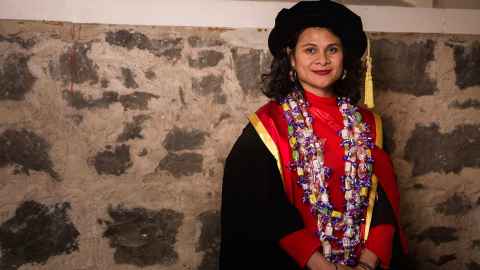Teaching architectural students to listen to the people who often aren’t heard
25 September 2019
Dr Karamia Müller formally graduated this week with a PhD in Architecture and is believed to be the first Sāmoan woman in the world to do so, and certainly the first from the University of Auckland.

She joined the School of Architecture and Planning this year as a lecturer, where she teaches Oceanic Architecture and Design as Research Architecture Studio courses.
In August she was shortlisted for the Education Prize for Early Career Academics by the Association of Architecture Schools of Australasia (AASA), the only New Zealand academic among the five finalists from across the region.
This was for a Design as Research studio project run by Dr Müller in which stage 2 architecture students worked as a group to design a housing development in Glen Innes, Auckland, a low-income, working class area with a large amount of state housing stock.
It was also the site of a housing regeneration project that began in 2016 and attracted headlines after residents protested against what they called a gentrification process that would displace residents. The protests escalated in 2017 when local Niki Rauti was served an eviction notice, houses were demolished, and residents relocated.
Students worked as a group on an architectural design brief that included housing and a community centre, but more unusually, took a journalistic approach in their research. That is, the students were asked to uncover the voices of displaced Glen Innes residents, what the site meant to them, how their experience of the site could, in a better world, inform the design of urban regeneration and housing.
It was about developing an understanding of the site through people’s experiences and narratives
“It was about developing an understanding of the site through people’s experiences and narratives,” says Dr Müller.
That meant delving behind the headlines in mainstream media, to find stories that could be found through online sources, which captured the lesser publicised experiences of marginalised groups such as women, indigenous people and lower socioeconomic groups, which they drew on to inform their design.
Design has the potential to create greater equity in the built realm, she says, which is is motivating for students, and keeps her passionate about architectural education.
Dr Müller agrees that as a Sāmoan woman she is more alert to inclusiveness in architecture and how critical it is to listen to all voices, particularly those of marginalised peoples and communities.
“I’m aware that there aren’t many Pacific women, in academia or in architectural practice. I’m hopeful that it will be helpful for others to see a Pacific woman working in the academic environment. You hope that your presence can make a difference.”
As part of her service role, she recently organised the bi-annual Fast-Forward lecture series, with some of the talks held at Objectpace, Ponsonby, in which architectural activists and experts talk about more inclusive architectural practices, particularly in the public rather than domestic realm.
Media contact
Margo White I Media adviser
DDI 09 923 5504
Mob 021 926
Email margo.white@auckland.ac.nz